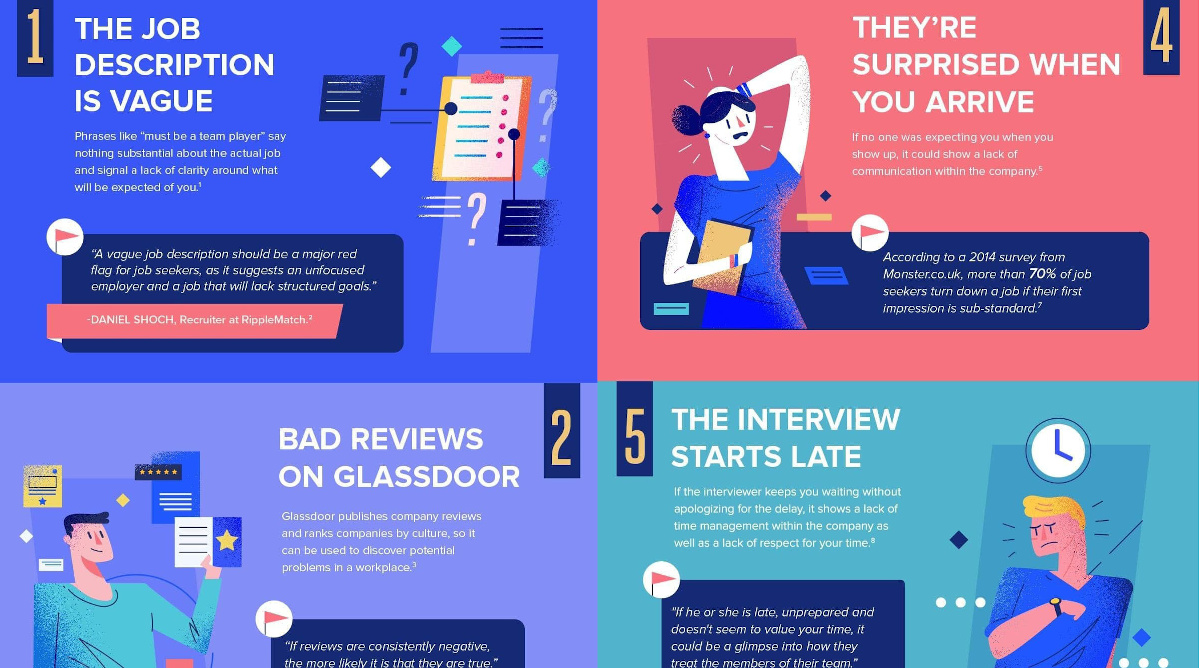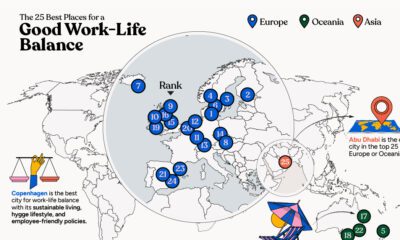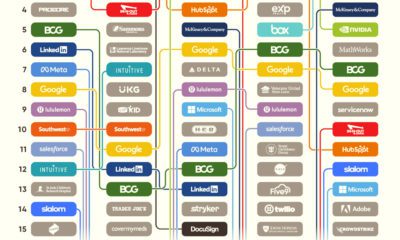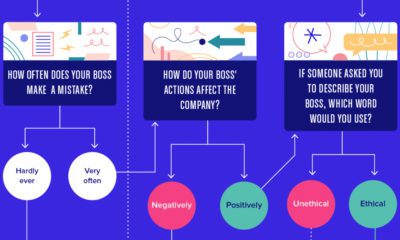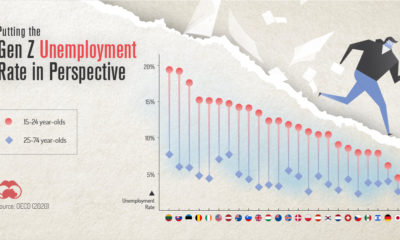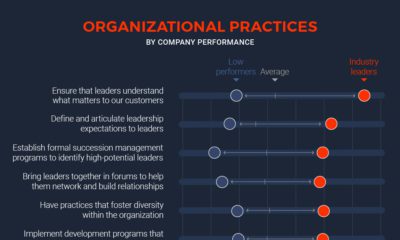Business
15 Warning Signs to Identify a Toxic Work Environment Before Taking a Job
According to Gallup, 85% of the world’s one billion full-time employees are unhappy at work.
While there are a number of reasons that contribute towards job dissatisfaction, a toxic work environment can have a significant impact on an employee’s performance, not to mention their physical and mental health.
But identifying red flags before accepting a job offer can be difficult; companies often sell themselves as a model workplace, when in reality, their inner workings are hugely problematic.
How to Identify a Toxic Work Environment
Today’s graphic comes to us from resume.io and it illustrates the 15 warning signs to look out for before, during, and after a job interview.

Lifting the Corporate Veil
A toxic work environment diminishes productivity by breeding a culture of discrimination, disorganization, bullying, and may even be fueled by unethical or selfish motivations.
Luckily, prospective employees can avoid 40 hours of torment a week by probing the company’s culture before signing on the dotted line. Here is a list of things to look out for:
Before the Interview
For better or worse, first impressions matter. Although excitement levels may be high, it’s important to pay attention to potential missteps, even before the interview starts.
- Vague job description: There should be clarity around the roles and responsibilities associated with the job, even if it is a new role in the company.
- Negative reviews on Glassdoor: Company review platforms are quickly becoming an indispensable tool for jobseekers who are interested in learning more about previous and current employees’ experiences.
- It took a long time to arrange an interview: Companies should show respect for the interviewee by getting back to them in a timely manner.
- Forgetting interviews: This could suggest that either the company has serious communication issues, or they do not prioritize interviewing potential employees.
- The interview starts late: Punctuality is not only expected from the person being interviewed, the interviewer should also be on time.
During the Interview
Adrenaline may be pumping when the interviewee is in the hot seat, but it’s crucial that they take stock of how the interviewers are conducting themselves.
- Unprepared interviewers: If the interview lacks structure, this could signal a disorganized team and a lack of clear expectations for the role.
- No interest in listening: Both parties need to put their best foot forward in an interview, to make sure that the interviewee’s personality and skill set aligns with the company, and vice versa.
- Authoritarian interviewer: This may indicate a lack of respect for employees.
- Inability to communicate company values: If company values are embodied by employees, then they should be top of mind and easily communicated.
- Questions are skimmed over: Companies should be transparent and be willing to provide comprehensive answers to any questions an interviewee may have.
After the Interview
In addition to assessing their own performance, interviewees should give careful consideration to how the entire interview experience went.
- Short interview: Either the company has already chosen another candidate, or they are desperate to fill the role as quickly as possible.
- Quiet workspace: A lack of teamwork or fearful employees could be the culprit for a silent office.
- No office tour: Companies should always give prospective employees a glimpse into what their day-to-day could look like by showing them around and introducing them to the team.
- Job offer was given on the day of the interview: The company could be trying to restrict the interviewee doing further research into the company, or simply filling the role as quickly as possible.
- Delayed decision-making: Failing to get back to someone who has done an interview shows a lack of respect for their time or disorganization on the company’s end.
It’s also worth mentioning that mistakes can be made by anyone, so it is perhaps not helpful to scrutinize companies for small errors in judgement when most of the experience has been positive.
Regardless, if there are any looming uncertainties, it is up to the person being interviewed to ask.
Finding the Courage to Ask Questions
When it comes to interviews, questioning the culture of the company is just as important as questioning the interviewee on their knowledge and skills.
“He who asks a question may be a fool for five minutes. He who does not ask questions, remains a fool forever.”
—Ancient Chinese proverb
Switching jobs is rarely an easy process, especially when jobseekers have come up against unforeseen challenges as a result of COVID-19.
But it is more important than ever for people to do their due diligence, and be brave enough to ask tough questions. Otherwise, they may have to repeat the cycle all over again—much sooner than they would have thought.
Brands
How Tech Logos Have Evolved Over Time
From complete overhauls to more subtle tweaks, these tech logos have had quite a journey. Featuring: Google, Apple, and more.

How Tech Logos Have Evolved Over Time
This was originally posted on our Voronoi app. Download the app for free on iOS or Android and discover incredible data-driven charts from a variety of trusted sources.
One would be hard-pressed to find a company that has never changed its logo. Granted, some brands—like Rolex, IBM, and Coca-Cola—tend to just have more minimalistic updates. But other companies undergo an entire identity change, thus necessitating a full overhaul.
In this graphic, we visualized the evolution of prominent tech companies’ logos over time. All of these brands ranked highly in a Q1 2024 YouGov study of America’s most famous tech brands. The logo changes are sourced from 1000logos.net.
How Many Times Has Google Changed Its Logo?
Google and Facebook share a 98% fame rating according to YouGov. But while Facebook’s rise was captured in The Social Network (2010), Google’s history tends to be a little less lionized in popular culture.
For example, Google was initially called “Backrub” because it analyzed “back links” to understand how important a website was. Since its founding, Google has undergone eight logo changes, finally settling on its current one in 2015.
| Company | Number of Logo Changes |
|---|---|
| 8 | |
| HP | 8 |
| Amazon | 6 |
| Microsoft | 6 |
| Samsung | 6 |
| Apple | 5* |
Note: *Includes color changes. Source: 1000Logos.net
Another fun origin story is Microsoft, which started off as Traf-O-Data, a traffic counter reading company that generated reports for traffic engineers. By 1975, the company was renamed. But it wasn’t until 2012 that Microsoft put the iconic Windows logo—still the most popular desktop operating system—alongside its name.
And then there’s Samsung, which started as a grocery trading store in 1938. Its pivot to electronics started in the 1970s with black and white television sets. For 55 years, the company kept some form of stars from its first logo, until 1993, when the iconic encircled blue Samsung logo debuted.
Finally, Apple’s first logo in 1976 featured Isaac Newton reading under a tree—moments before an apple fell on his head. Two years later, the iconic bitten apple logo would be designed at Steve Jobs’ behest, and it would take another two decades for it to go monochrome.
-

 Green1 week ago
Green1 week agoRanked: The Countries With the Most Air Pollution in 2023
-

 Automotive2 weeks ago
Automotive2 weeks agoAlmost Every EV Stock is Down After Q1 2024
-

 AI2 weeks ago
AI2 weeks agoThe Stock Performance of U.S. Chipmakers So Far in 2024
-

 Markets2 weeks ago
Markets2 weeks agoCharted: Big Four Market Share by S&P 500 Audits
-

 Real Estate2 weeks ago
Real Estate2 weeks agoRanked: The Most Valuable Housing Markets in America
-

 Money2 weeks ago
Money2 weeks agoWhich States Have the Highest Minimum Wage in America?
-

 AI2 weeks ago
AI2 weeks agoRanked: Semiconductor Companies by Industry Revenue Share
-

 Travel2 weeks ago
Travel2 weeks agoRanked: The World’s Top Flight Routes, by Revenue

